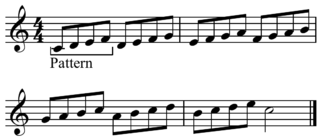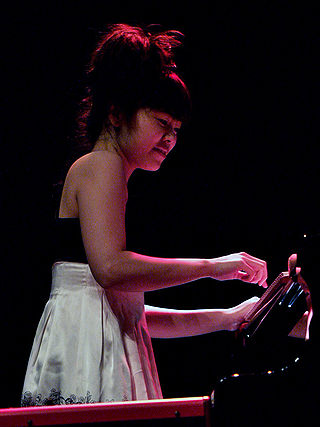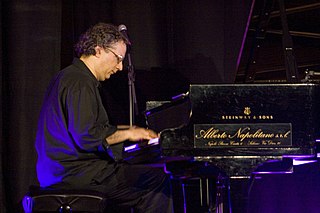Related Research Articles
An altered chord is a chord that replaces one or more notes from the diatonic scale with a neighboring pitch from the chromatic scale. By the broadest definition, any chord with a non-diatonic chord tone is an altered chord. The simplest example of altered chords is the use of borrowed chords, chords borrowed from the parallel key, and the most common is the use of secondary dominants. As Alfred Blatter explains, "An altered chord occurs when one of the standard, functional chords is given another quality by the modification of one or more components of the chord."
John Francis Mehegan was an American jazz pianist, lecturer and critic.
The Hartt School is the performing arts conservatory of the University of Hartford, a private university in West Hartford, Connecticut. Founded in 1920 by Julius Hartt and Moshe Paranov, Hartt has been part of the University of Hartford since its charter merged the then Hartt College of Music, the Hartford Art School, and Hillyer College to create the university in 1957. The Hartt School offers undergraduate and graduate degrees in music, dance, theatre, and associated disciplines. The Hartt Community Division offers a variety of opportunities in music and dance for students of all ages, backgrounds, and abilities.
Gregg Bendian is an American jazz drummer, percussionist, pianist, and composer.

David Liebman is an American saxophonist, flautist and jazz educator. He is known for his innovative lines and use of atonality. He was a frequent collaborator with pianist Richie Beirach.

In music and jazz improvisation, a melodic pattern is a cell or germ serving as the basis for repetitive pattern. It is a figure that can be used with any scale. It is used primarily for solos because, when practiced enough, it can be extremely useful when improvising. "Sequence" refers to the repetition of a part at a higher or lower pitch, and melodic sequence is differentiated from harmonic sequence. One example of melodic motive and sequence are the pitches of the first line, "Send her victorious," repeated, a step lower, in the second line, "Happy and glorious," from "God Save the Queen".

Japanese jazz is jazz played by Japanese musicians, jazz connected to Japan or Japanese culture, or both. The term often refers to the history of jazz in Japan, which has the largest proportion of jazz fans in the world, according to some estimates. Jazz was first introduced in Japan in the 1910s through transpacific ocean liners, where Filipino musicians took influences from jazz, with the Philippines being an American colony at the time. Following the music recording industry's rise in the 1920s, the lyrics of popular jazz records like "The Sheik of Araby" and "My Blue Heaven" were translated into Japanese. Jazz was associated with native counterparts to flappers and dandies in Japan, often being played in dance halls. Although considered "enemy music" in Japan during World War II, due to its American roots, the genre was far too popular for the complete ban of the music to be viable, and many disobeyed the state mandated destruction of jazz records. Following the surrender of Japan in the second World War, there was a large demand for entertainment for American troops, and jazz was particularly popular. By the 1970s, the Japanese economic miracle paved way for Japanese jazz musicians to achieve international fame, along with new musical genres such as city pop, kankyō ongaku, and japanese folk music. Japanese jazz musicians also began to evolve past Blue Note mimicry, and instead experimented with free jazz, fusion funk, and bebop, among others. This furthered the distinct sound of Japanese jazz. During the 1980s, digital music technology began to influence the Japanese jazz scene.

Uri Caine is an American classical and jazz pianist and composer.

Bradford Alexander Mehldau is an American jazz pianist, composer, and arranger.

Straight-ahead jazz is a genre of jazz that developed in the 1960s, with roots in the prior two decades. It omits the rock music and free jazz influences that began to appear in jazz during this period, instead preferring acoustic instruments, conventional piano comping, walking bass patterns, and swing- and bop-based drum rhythms.

Wayne Escoffery is an American jazz saxophonist.

Thomas Chapin was an American composer and saxophonist and multi-instrumentalist. His music spanned the full range of 20th century creative music, from his time as Lionel Hampton's bandleader to modern jazz and his own avant-garde explorations. He helped create the Knitting Factory scene in New York City in the early 80's and was the first artist signed to Knitting Factory Records. Though primarily an alto saxophonist, he also played sopranino, as well as soprano, tenor, baritone saxes and flute. Many of his recordings as a leader were in a trio with bassist Mario Pavone and drummer Michael Sarin. Chapin studied with Jackie McLean, Paul Jeffrey, Kenny Barron, and Lionel Hampton. He died of leukemia three weeks before his 41st birthday. He played at a benefit concert two weeks before his death.
John Livingston Eaton is an American pianist, musicologist, humorist, educator and interpreter of jazz and American popular music. He is "considered one of the foremost interpreters of American music."
Locked hands style is a technique of chord voicing for the piano. Popularized by the jazz pianist George Shearing, it is a way to implement the "block chord" method of harmony on a keyboard instrument.
William Barron, Jr. was an American jazz tenor and soprano saxophonist.

This is a timeline documenting events of Jazz in the year 1996.

Kristopher Bowers is an American composer and pianist. He has composed scores for films, including Green Book, King Richard, and television series, among them Bridgerton, Mrs. America, Dear White People, and When They See Us.

This is a timeline documenting events of Jazz in the year 2008.

This is a timeline documenting events of jazz in the year 2021.
References
- ↑ P4MU (2000-03-06). "Noah Baerman". P4MU. Retrieved 2022-07-02.
- ↑ "Pianist Noah Baerman's Art and Activism Overcome Adversity". Connecticut Public. 2014-03-13. Retrieved 2022-07-02.
- ↑ "(VIRTUAL) Conversation with Noah Baerman | Yale College Arts". collegearts.yale.edu. Retrieved 2022-07-02.
- ↑ "Noah Baerman". noahjazz.com. Retrieved 2022-07-02.
- ↑ "Noah Baerman – Resonant Motion" . Retrieved 2022-07-02.
- ↑ "Straight No Chaser - A Jazz Show: Podcast 428: A Conversation with Noah Baerman". straightnochaserjazz.libsyn.com. Retrieved 2022-07-02.